February 22nd, 2022 by Hope Charters
Let your love of the Great Lakes have an impact. Challenge yourself to try something new to prevent pollution in Lake Michigan and beyond. All 22 actions won’t work for everyone, but taking one action can make a difference.
Follow @GreatLakesP2 and #P2Tuesday on Twitter for more pollution prevention inspiration.

At home and work
- Properly dispose of unwanted medications to protect people, pets, and the environment. Find a collection site at unwantedmeds.org.
- Make your own cleaning products. By using less toxic ingredients you can reduce the threat of accidental exposure and pollution of the environment.
- Discover toxin-free household cleaning product alternatives with this publication from New Mexico State University Cooperative Extension Service. https://aces.nmsu.edu/pubs/_g/G315.pdf
- Turn off unused lights, appliances and equipment when they are not in use. Measure the impact of your energy use on the environment with several tools from the Environmental Protection Agency. https://www.epa.gov/energy/measure-impact-your-energy-use-environment?utm_source=agency-website&utm_medium=social&utm_campaign=&utm_term=&utm_content=
- Extend the life of equipment and products – repair or buy second-hand. Check out some helpful tips from the Illinois Sustainable Technology Center. https://blog.istc.illinois.edu/2018/09/18/p2week-day-2-reducing-your-impact-through-repair/
- Identify source reduction strategies. Evaluate the materials that produce waste at work. Try eliminating non-essentials, improving operating practices, purchasing more durable products, or replacing materials to reduce toxicity. The Indiana Department of Environmental Management has pollution prevention resources for Indiana business: https://www.in.gov/idem/ctap/pollution-prevention-p2-for-indiana-businesses/
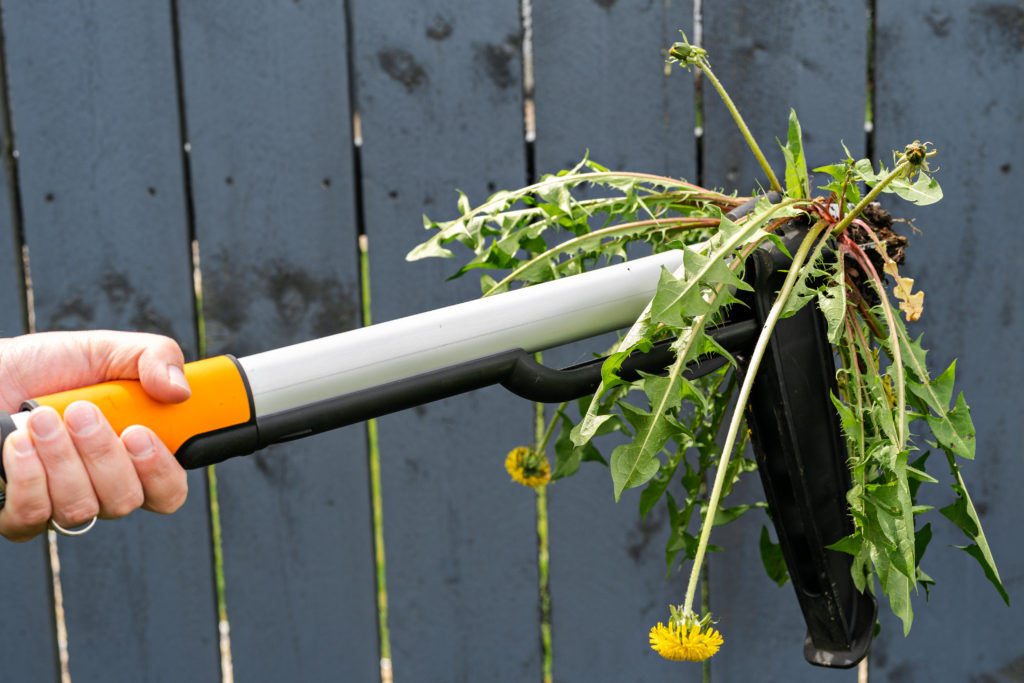
In your yard
- Before applying fertilizer to your lawn, always consider soil test results, desired lawn quality, and maintenance preferences. Find more information from Lawn to Lake about how to fertilize appropriately and protect local water resources.
- Use integrated pest management to control pests with fewer pesticides while creating favorable growing conditions for your lawn. Midwest Grows Green provides toolkits, guides, and factsheets to help you reduce the need for pesticides.
- Mow smart to develop a deeper root system and reduce your dependence on irrigation and chemical fertilizers. Learn how to maximize your mowing practices on the Lawn to Lake website.
- Overwatering and misdirected watering practices result in wasted water and polluted runoff that may end up in nearby streams, rivers, lakes, and even groundwater. Lawn to Lake teaches you how to conserve water and control runoff on your property.
- Shrink your yard and plant natives, mowing less will reduce emissions. The Red Oak Rain Garden provides a number of native planting garden guides to get you started.
- Compost your food waste and by adding it to your garden and grass you can both mitigate greenhouse gas emissions and improve soil fertility.
- Pick-up pet waste to protect water quality. Pet waste can carry two types of pollutants into our waterways, nutrients and pathogens. Learn more about this from the Great Lakes Echo’s Scooping Poop Improves Water Quality.
- Salt keeps our sidewalks and streets safe but it can also pollute local waterways. Save money by sweeping up and reusing excess salt. Visit saltsmart.org for more tips.

At the store
- Reduce household hazardous waste by reading labels and choosing the least toxic products. Search for products that meet the EPA’s Safer Choice Standards.
- Buy in bulk to reduce packaging and food waste. North Carolina State University’s Sustainability office has a list of 5 things to buy in bulk.
- When you can, choose natural fiber materials like cotton, linen, wool, silk to prevent microplastic pollution. Learn more with Delaware SeaGrant’s microfiber factsheet.
- Reduce the need to harvest new materials by choosing reusable mugs, straws, and utensils when you can.

On the go
- Don’t idle your vehicle when you are not driving. Learn more with this factsheet from the U.S. Department of Energy.
- Choose a pollution-free mode of transportation when possible. Try walking or riding a bike for trips less than one mile. The EPA outlines what good could happen if we kept our cars parked for trips less than one mile.
- Prevent pollution by washing your car in a commercial car wash facility where wastewater can be filtered and recycled or properly disposed. The Illinois Environmental Protection Agency provides information about the requirements governing car wash wastewater and how these facilities can become more environmentally friendly and conserve water.
- Don’t litter. Wind, rain, streams, and rivers can deposit marine debris (trash) into our Great Lakes. The NOAA Marine Debris Program works to prevent marine debris from entering the Great Lake through education, outreach, and removal projects.
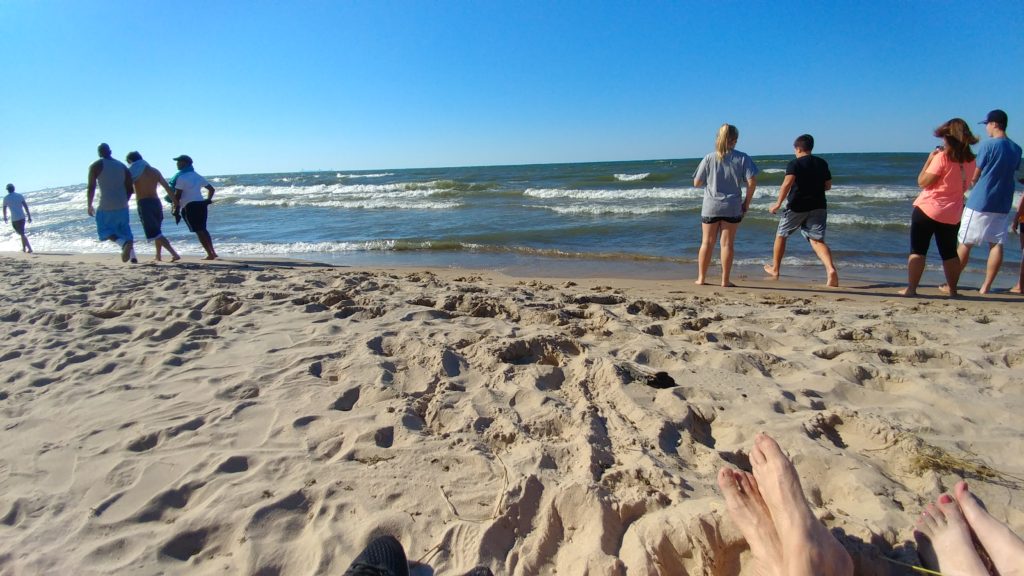
Sharing is caring
As we aim for progress not perfection, remember that individual actions matter. Share these pollution prevention tips with others and then get involved! IISG connects people with science to help protect southern Lake Michigan ecosystems and build resilient communities. Look for opportunities to get engaged.
Illinois-Indiana Sea Grant is a part of University of Illinois Extension and Purdue Extension.
Contacts: Janice Milanovich, Sarah Zack
February 16th, 2022 by Hope Charters
Location: Carmel, Indiana
Organization: Clay Middle School
Grade: 6th
Subject: Science
Why do you think it’s important to infuse Great Lakes topics in education?
Invasive species pose a threat to our ecosystems, and our Great Lakes. My students are gaining an understanding of the fragility of those species we love to find in the Great Lakes and also how dangerous new invasive species would be if introduced to the Great Lakes.
Describe one of your favorite classroom experiences or activities associated with the Great Lakes.
“Everywhere we look, there are species damaging our natural ecosystems both now, and as we look into the future.” Sixth grade science students at Clay Middle School were tasked with coming up with creative solutions for solving these ecological problems. Students presented to members of the local scientific community who are on the front lines of Indiana’s invasive species problems. Members of this professional audience included scientists from the following institutions: Indiana Department of Natural Resources, Purdue University, Illinois-Indiana Sea Grant, Carmel Clay Parks and Recreation, Indiana Department of Transportation, Southern Indiana Cooperative Invasives Management, Hamilton County Invasives Partnership, Hamilton Soil and Water Conservation District, and USDA National Resources Conservation Service.
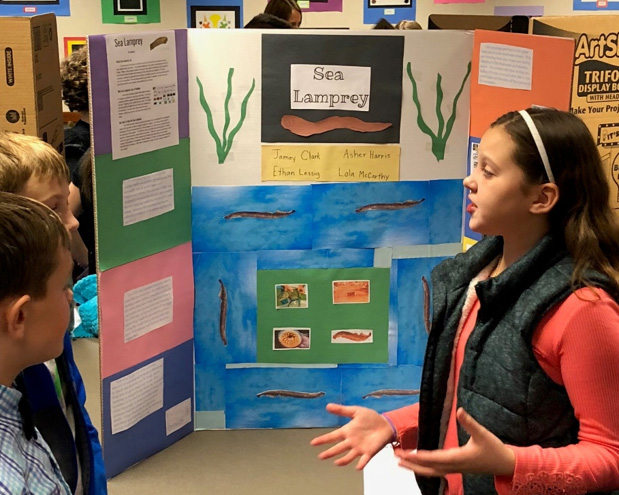
Students speak about sea lamprey problems and solutions at a student-led Invasive Species Symposium at Clay Middle School. (Photo provided by Steve Sturgis)
What teaching methods do you use to engage students in Great Lakes activities?
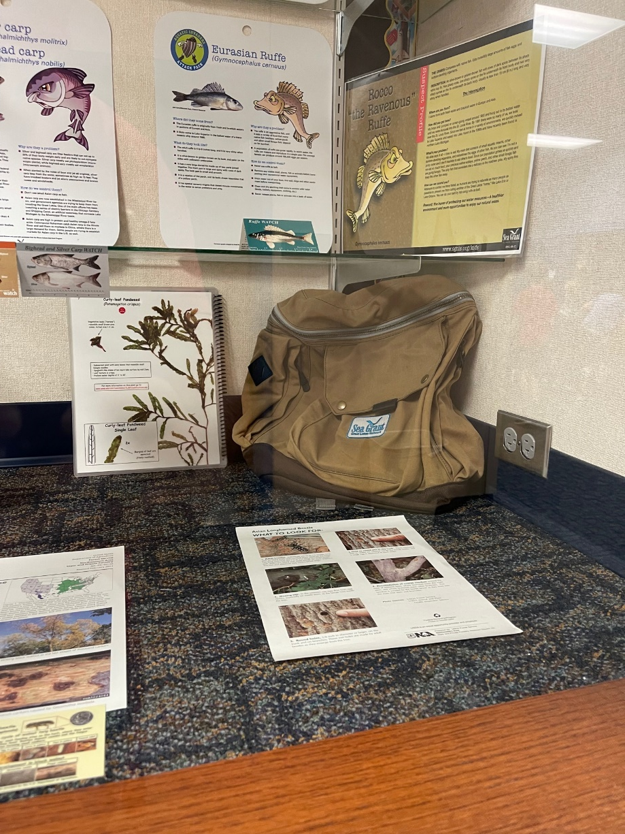
Sea Grant’s Attack Pack resources are a Center for Great Lakes Literacy classroom supplement to invasive species Project Based Learning. (Photo provided by Steve Sturgis)
Project Based Learning or PBL. Creating projects centered around solving real problems creates a natural opportunity for students to learn curriculum in a more meaningful and engaging environment for learning.
How have you involved scientists in your teaching?
At the end of our PBL study “Invasive Species, Can They Be Stopped?” students present their unique solutions to the invasive species problem to a professional panel that consists of members of agencies that work directly with invasive species in the local community.
Student Reflections on Great Lakes stewardship
“I had no idea how many invasive species Indiana had wrecking ecosystems. This project was a fun way to learn about a species and come up with a clever way that scientists could maybe use someday to stop these invaders.” – Student at Clay Middle School
Illinois-Indiana Sea Grant is a part of University of Illinois Extension and Purdue Extension.
Contact: Steve Sturgis, ssturgis@ccs.k12.in.us
Education and Student Engagement Coordinator: Terri Hallesy
Center for Great Lakes Literacy: https://www.cgll.org/teacherfeature/steve-sturgis/
January 11th, 2022 by Hope Charters
Illinois-Indiana Sea Grant (IISG) is searching for an AIS specialist to work with the Illinois Natural History Survey to develop, direct, and assess the effectiveness of outreach and engagement activities for various stakeholders needing scientific information on Aquatic Invasive Species (AIS) affecting Lake Michigan and the inland waters of Illinois and Indiana, as well as conduct social science research to help guide outreach efforts. Master’s degree—PhD preferred—related to subject matter emphasis and relevant experience are required. To view the complete job description and apply, visit the listing on the University of Illinois website. Closing date is January 28, 2022.
INCLUSION AND EQUAL OPPORTUNITY
University of Illinois is an equal access/equal opportunity university. We strongly encourage women, minorities, and people from traditionally underrepresented groups to apply. For more on Illinois-Indiana Sea Grant’s commitment to inclusion, please see our values statement.
Job Duties
Outreach
- Contribute in the area of outreach and engagement in the service of INHS (Illinois Natural History Survey), PRI (Prairie Research Institute), IISG (Illinois-Indiana Sea Grant), the University, and the states of Illinois and Indiana.
- Seek and secure external funding to maintain a robust outreach and research program.
- Provide strategic leadership and oversight of the AIS outreach program.
- Develop and deliver a variety of science-based outreach tools regarding aquatic invasive species (AIS) to address the needs of a wide range of stakeholders in Illinois, Indiana, and the wider Great Lakes region.
- Ensure that programming addresses the diversity of stakeholders
- Present outreach findings and activities in peer-reviewed literature and at conferences and meetings.
- Maintain strong working relationships within Illinois-Indiana Sea Grant (IISG).
- Develop new and maintain existing partnerships throughout the Great Lakes region.
- Represent the Survey, PRI, IISG, and the University of Illinois on committees by serving on local, state, regional, and federal committees.
Research
- Conduct social science research that informs programmatic outreach activities.
- Evaluate the effectiveness of the AIS program’s outreach activities.
- Develop research collaborations with partners from agencies, non-government organizations, and academic institutions.
- Present research findings and activities in peer-reviewed literature as well as via conferences and meetings.
Administration and Mentoring
- Supervise and lead staff to achieve success and foster a culture of innovation and high-level performance at both individual and organizational levels. This includes task assignment, scheduling, and ongoing performance management with coaching and feedback, and travel approval.
- Oversee administration of grants including budgeting, reporting, and other principal investigator duties.
- Advise, supervise, and mentor undergraduate and graduate students as time permits.
- Serve on graduate advisory committees as time permits.
- Prepare internal reports, reports to sponsoring agencies, and scientific reports for distribution to stakeholders.
APPLICATION
To apply, go to https://jobs.illinois.edu/academic-job-board/job-details?jobID=156761&job=vst-asst-research-sci-aquatic-invasive-species-engagement-il-natural-history-survey-pri-156761. Log in to your account and upload a cover letter and resume as well as the names and contact information of three professional references. Resume dates must be in month/year format and employment history, at a minimum, should include all work dating back to the completion of your undergraduate degree. Positions that were less than full-time/100% must be noted as being part-time. Transcripts may be requested at a later date. To receive full consideration, all requested application materials must be submitted via the online system by the close date of January 28, 2022.
Illinois-Indiana Sea Grant is a part of University of Illinois Extension and Purdue Extension.
January 5th, 2022 by Hope Charters
“Meet Our Grad Student Scholars” is an article series from Illinois-Indiana Sea Grant (IISG) celebrating the graduate students doing research funded by the IISG scholars program. To learn more about our faculty and graduate student funding opportunities, visit our Fellowships & Scholarships page.
Alexandra (Ali) Touloupas is a master’s student in Plant Biology and Conservation joint program with Northwestern University and the Chicago Botanic Garden, and is part of the inaugural Illinois-Indiana Sea Grant Graduate Student Scholars cohort. She is interested in rare plant conservation and the impacts of climate change on bog and fen species. Her work involves monitoring and modeling rare plant distributions, and how critical habitat may be impacted by climate change. Ali has earned two bachelor’s degrees, learning about Plant Biology from North Carolina State University and Sociology from Mount Holyoke College. Ali enjoys hiking and exploring new natural areas, and stopping in antique stores along the way.
As a master’s student and scientist who studies rare plant species, Alexandra (Ali) Touloupas has partnered with the Chicago Botanic Garden to record current populations and predict how rare plant species may respond to climate change. This project has many components, some of which require Touloupas to survey rare species, model habitat suitability, calculate statistical predictions, and predict future climate scenarios in wetlands.
The rare plants Touloupas studies are considered high priority species. These species were chosen by expert ecologists and botanists because more data is needed to update their conservation status. Last year, she worked as a research assistant for the Plants of Concern program at Chicago Botanic Garden, coordinating and conducting rare plant monitoring throughout Cook County during the field season. In late fall, she analyzed annual monitoring data to detect population trends. This position helped Touloupas understand the potential impact of her work on rare plant monitoring initiatives.
A typical research day for her depends on the season. In the summer, she does a lot of hands-on field work and sometimes turns into a modern-day Sherlock Holmes to find a specific plant. According to Touloupas, the detective work that goes into determining the locations of rare species is sometimes daunting but always fun. First, she looks for the last known coordinates of her species by accessing records from the Illinois Natural Heritage website. The data and coordinates can only be accessed through a confidentiality agreement to protect rare plants and their habitats from trampling and poaching. Then, she uses a GPS to get herself to the location. This can be tricky for a few reasons; bogs and wetlands are hard to move through, even when someone knows where they are going. And while getting stuck in the muck with boots sinking into the ground, Touloupas must be careful not to disturb the fragile habitat.
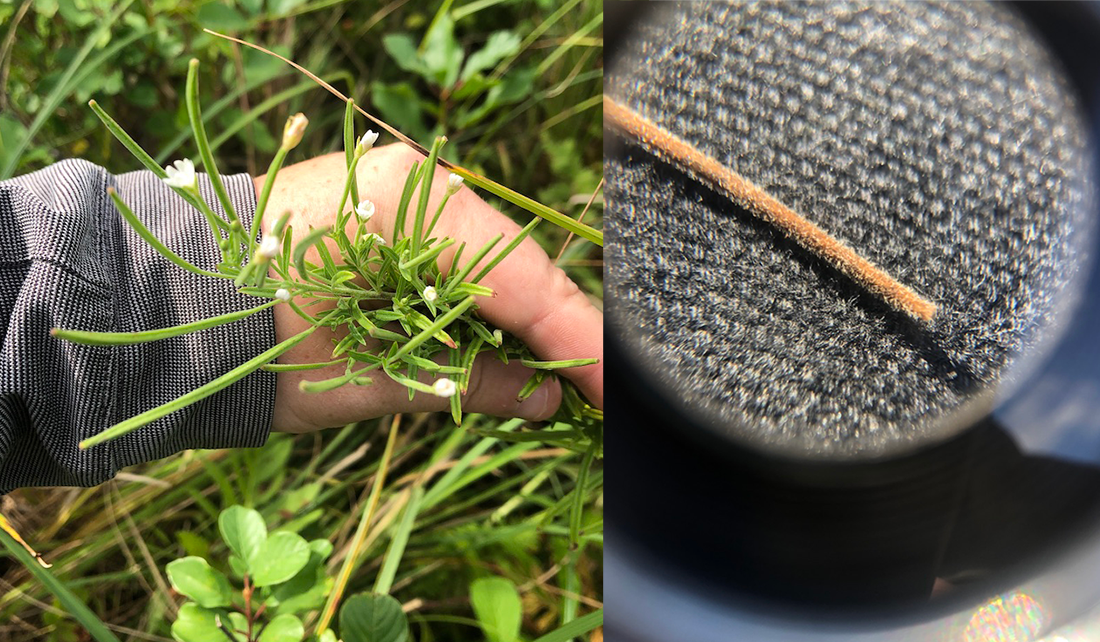
Using a hand lens is crucial to see the dense hairs that distinguish this species that Touloupas is studying, Epilobium strictum, from other species. (Photo provided by Alexandra Touloupas)
Last summer, she drove long distances to get to field locations and sometimes even camped overnight near the sites. The plants she is focused on live in bogs and fens—wetlands that accumulate lots of peat and runoff. Certain indicator species, which have adapted to the harsh conditions, help Touloupas know she is getting closer to her rare plants… or at least where they used to be. Some of the species she hunts for were last seen 50 years ago, so she never knows what she will find.
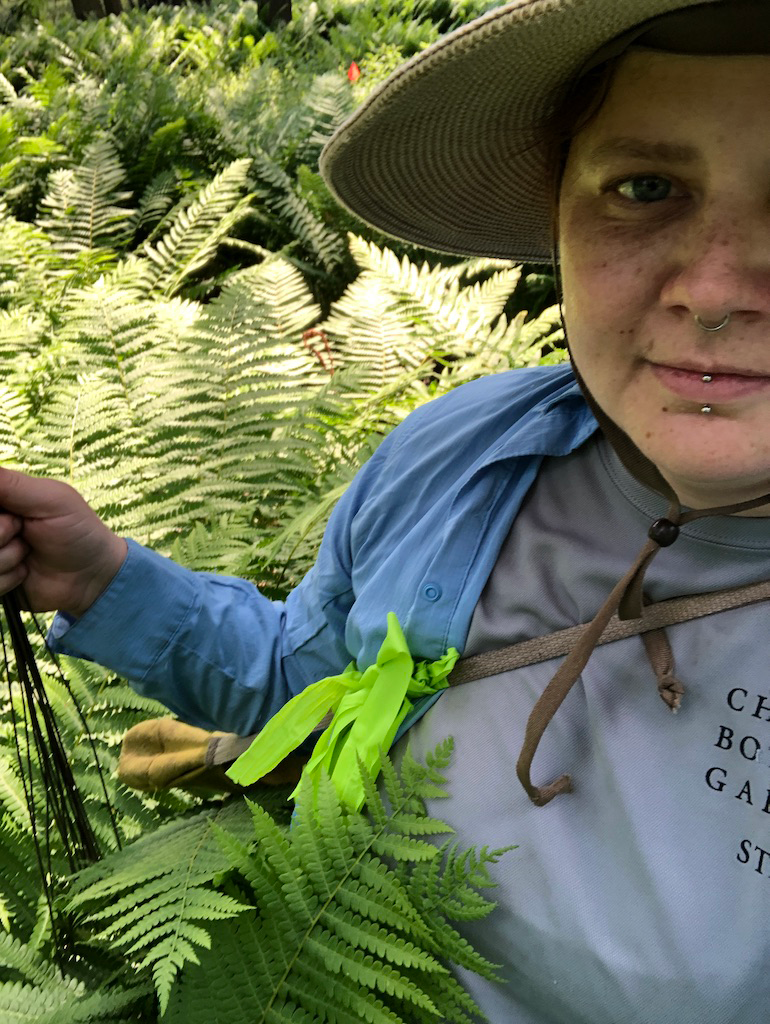
Sometimes Ali has to wade through ferns and other flora nearly as tall as she is when looking for rare species, as shown here during field work for Chicago Botanic Garden’s Plants of Concern program. (Photo provided by Alexandra Touloupas)
A lot can happen over 50 years, including immense ecological changes. For example, cattails take over what was once a diverse bog, or an invasive animal could eat a whole population of plants. When Touloupas finds a rare plant species, she takes their new GPS coordinates as well as detailed notes and photos. Nothing is too small to be observed. She notes if plants are growing on a slope, in shade or sun, and especially looks for things that might not allow for long-term survival. Because ecological landscapes are always changing, she also takes note of small signs that indicate what might become of the sites, particularly if new bogs and fens are forming.
The next phase of Touloupas’ research is to process the data she collected during her fieldwork. She plans to incorporate the spatial data she collected about rare plants into possible climate change scenarios. Since climate change is so complex, Touloupas must compile scenarios with many different variables. She chose to include temperature and precipitation, soil type and soil characteristics, acidity of soil, and relationships to geology and glaciers. To understand conditions that enable her species to persist, Touloupas uses information from GIS datasets and remote sensing images. Land use will also be factored into the scenarios, including distances from developments that may produce harmful runoff, because wetlands are particularly sensitive to pollutants. Ultimately, Touloupas plants to contextualize her findings in various climate scenarios, like those created by the Intergovernmental Panel on Climate Change.
One of her proudest accomplishments is learning how to process data with the R coding language. She is using GIS mapping and R to model possible futures for her rare plants. To do this, she uses statistical analysis and strategic model selection. When she has combined all her results together, Touloupas plans to share best practices with organizations that want to conserve rare plants, such as suggesting sites where the plants could be reintroduced.
When she started graduate school, Touloupas thought of it as a career move and personal milestone that would secure an appealing job. After some time at Northwestern, she was surprised to find that graduate school itself is lots of fun. Being back in academia, around other people doing research and learning from their processes, has inspired her to dig into the field. She is particularly thankful for the support for her own research. She feels more empowered to do plant biology work and is even considering more research in the future.
To any aspiring plant scientists, Touloupas recommends gaining experience by working seasonal jobs or completing internships to test different roles and find something inspiring. “Find what you like and what works best for you,” she said. “Listen to podcasts and lectures, either in person or online, to get inspired by other people’s research and to see what’s possible. There is a lot of creativity that goes into designing a research project.”
Touloupas learned about the rare plants she is studying by taking classes during the first part of her degree. The graduate-level courses involved plenty of literature reviews, through which she learned about the latest research in plant biology. Additionally, folx who have worked in the areas for decades took students into the field to share their data collection processes and tips. She also tried to absorb all the information she could through books like “A Great Lakes Wetland Flora” and a few key organizations. The Illinois Wildflowers website, US Department of Agriculture and Illinois Natural History Survey resources were particularly helpful. Touloupas hopes that the final results of her study will end up help in one of these public resources.
You can learn more about the exciting research that Ali is conducting at Northwestern University by following @aktouloupas on Twitter and big_al_botany on Instagram.
Illinois-Indiana Sea Grant is a part of University of Illinois Extension and Purdue Extension.
Writer: Sarah Gediman
Contact: Carolyn Foley
December 29th, 2021 by Hope Charters
“Meet Our Grad Student Scholars” is an article series from Illinois-Indiana Sea Grant (IISG) celebrating the graduate students doing research funded by the IISG scholars program. To learn more about our faculty and graduate student opportunities for funding, visit our Fellowships & Scholarships page.
Jordan Holtswarth-Hartman is a PhD student in Natural Resources and Environmental Sciences at the University of Illinois at Urbana-Champaign, and part of the inaugural Illinois-Indiana Sea Grant Graduate Student Scholars cohort. She is interested in ecology and conservation and is currently looking at the impacts of Banded Killifish, a native transplant species in the Illinois-Indiana area. Jordan earned her bachelor’s degree in Fisheries and Wildlife from the University of Missouri – Columbia, and her MS in Biology from Tennessee Technological University, where she studied the transferability of habitat suitability models for freshwater mussels in Missouri. Jordan is an avid yogi and coffee enthusiast, and a mom to cat Ghost and bunny Luna.
PhD student Jordan Holtswarth-Hartman is studying the relationships between Eastern and Western Banded Killifish. She is comparing their ecological roles as well as whether the two are hybridizing, or breeding together. While their names indicate they live on opposite sides of North America, the two subspecies of Banded Killifish have come to inhabit much of the same territory over the past 20 years.
Western Banded Killifish typically live in kettle lakes, which are fed by underground rivers and streams. While originally from the eastern coast of the United States, not much is known about how the Eastern Banded Killifish became more common than its western counterpart in Lake Michigan and the Illinois River. Because Eastern and Western Banded Killifish look so similar, Holtswarth-Hartman needs to use stable isotopes and genetics to determine the ecological roles—the importance or function they play in the ecosystem—of the subspecies and whether they are hybridizing.
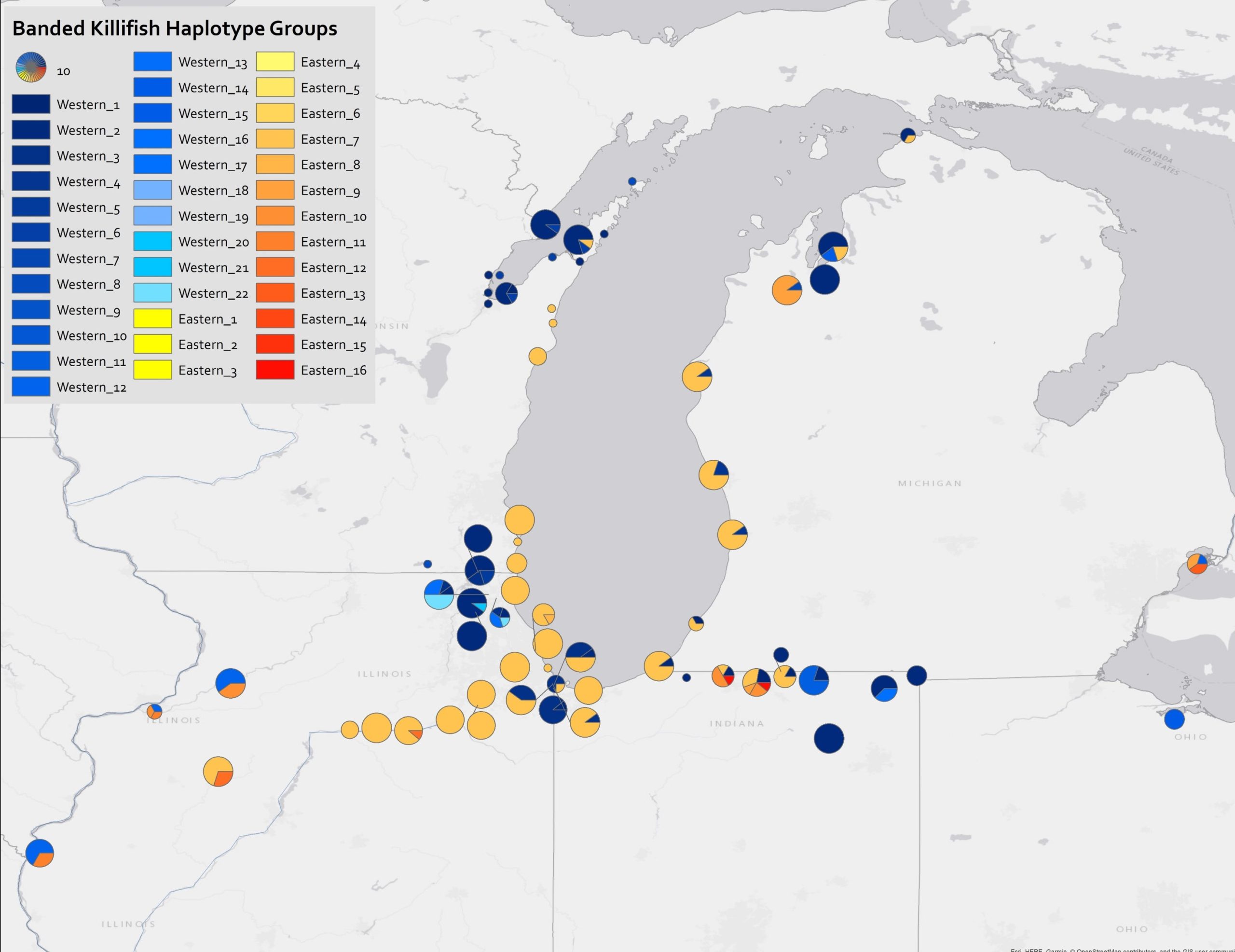
(Graphic provided by Larson Lab / University of Illinois at Urbana-Champaign)
So, what does it mean that at least some of the Banded Killifish are changing their habitats? Holtswarth-Hartman and the principal investigator on her project, Eric Larson, use the term native transplant to refer to species that are from the United States but have been moved outside their native range. Banded Killifish are also considered non-game fish, meaning there are no sport or commercial uses for them. There are an estimated 236 non-game, native transplants in the United States; they play an important ecological role in the greater Illinois-Indiana region, but are relatively under-studied.
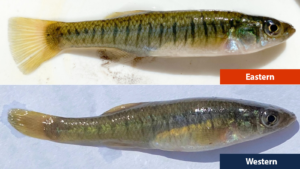
Jordan Holtswarth-Hartman of the Larson Lab is investigating the eastern banded killifish in the southern Lake Michigan region, a non-native lookalike of the native, Illinois state threatened western banded killifish. (Larson Lab / University of Illinois at Urbana-Champaign)
Holtswarth-Hartman is working with 727 fish samples, so the detail-oriented lab work she is completing is time-consuming but necessary to reach her research objectives. She has two main goals: first, to determine the trophic position of the two subspecies using stable isotopes; and second, to determine whether they are hybridizing using genetics.
A trophic position is an organism’s place in a food web, and helps define its ecological niche. Stable isotopes are two or more forms of the same element which have different numbers of neutrons. They are stable because they do not decay over time. Stable isotope values in muscle tissue differ based on diet, meaning Holtswarth-Hartman can deduce what fish eat and therefore where on the food chain they are. This gives a picture of the long-term diet, but there is another technique, called gut metabarcoding, that can reveal what the fish ate shortly before they were caught.
Holtswarth-Hartman studies the hybridization and genetics of Banded Killifish using a combination of mtDNA and RAD sequencing. Mitochondrial DNA, or mtDNA, is inherited from the mother, and tells Holtswarth-Hartman whether the fish is an Eastern or Western subspecies. However, because mtDNA is only inherited from the mother, it cannot be known if the fish is a hybrid. Once Holtswarth-Hartman knows the subspecies of the mother, she uses Restriction site Associated, or RAD, sequencing to determine if an individual fish is a hybrid. RAD sequencing uses nuclear DNA by looking at the polymorphic loci, or a set of DNA in which multiple alleles determine a single trait. When there is at least one allele from the mom and at least one allele from the dad, Holtswarth-Hartman can see if there is a combination of DNA from Eastern and Western subspecies.
While genetics have become a key part of her project, Holtswarth-Hartman did not have any background in the field before starting her PhD. Now, she says she has developed a love for genetics and has included three different genetic aspects in her project. “I have really enjoyed broadening my knowledge in many different areas such as genetics and sample collection,” Holtswarth-Hartman said. “On a personal level, I have been fortunate to build close relationships with new mentors and friends that have been a major help with all aspects of my PhD.” After she earns her doctorate, Holtswarth-Hartman is thinking about jobs in academia, government or for NGOs where she can apply her skills in habitat suitability modeling and genetics.
You can learn more about the exciting research that Jordan is conducting in the Larson Lab at University of Illinois Urbana-Champaign by following @JordanHHartman on Twitter or browsing her publications on Google Scholar or ResearchGate.
Illinois-Indiana Sea Grant is a part of University of Illinois Extension and Purdue Extension.
Writer: Sarah Gediman
Contact: Carolyn Foley
December 17th, 2021 by Hope Charters
CSMI, or the Cooperative Science and Monitoring Initiative, is an internationally-supported endeavor to collect and process data about the Great Lakes. Each year, scientists study a different Laurentian Great Lake. They spend up to a month on ships for their research, and to work together to answer broad questions about the health of the lake, generating data and information to help improve environmental management.
Lake Michigan was scheduled to be sampled in 2020, so IISG hosted the kickoff workshop funded by the International Joint Commission in 2018 to discuss sampling priorities. Unfortunately, the COVID pandemic delayed sampling, so in 2021 CSMI research focused on both Lake Michigan and Lake Superior, meaning ships and people had to split their time between the two lakes. While COVID protocols remained in place, researchers were tenacious and gathered exciting data.
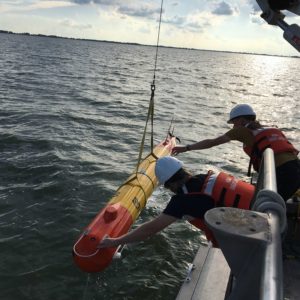
Long-range autonomous underwater vehicles can sample 24 hours a day, seven days a week, for as much as a couple of weeks at a time according to David Warner of USGS. (NOAA Great Lakes Environmental Research Laboratory)
A key theme during 2021 sampling of Lake Michigan was to collect data from a broader area than had been done during previous field years. While physical researchers and biologists from the NOAA Great Lakes Environmental Research Laboratory (NOAA-GLERL) deployed buoys and autonomous underwater vehicles—and conducted larval fish and other biotic sampling—off the coast of the long-sampled Muskegon, Michigan transect, researchers from the EPA Great Lakes Toxicology and Ecology Division Laboratory (EPA-GLTED), the USGS Great Lakes Science Center (USGS-GLSC) and other organizations also sampled extensively in the less-studied northern portion of Lake Michigan, plus included sampling of Green Bay and Grand Traverse Bay.
This intentional effort on the part of the researchers was designed to make the most of the longer-term datasets from the southern portion of the lake, while also filling in important data gaps to increase overall understanding of Lake Michigan ecosystems.
With regard to longer-term sampling, biologists from Buffalo State College, the EPA-GLTED office and NOAA-GLERL all gathered samples to explore the lower food web, including phytoplankton, zooplankton and benthic macroinvertebrates. Many of these sampling efforts are similar to Lake Michigan sampling efforts in 2010 and 2015, including using a benthic sled to assess benthic communities. Repeating sampling at the same locations, in the same ways, can help biologists understand if the food web makeup is changing or remaining the same.
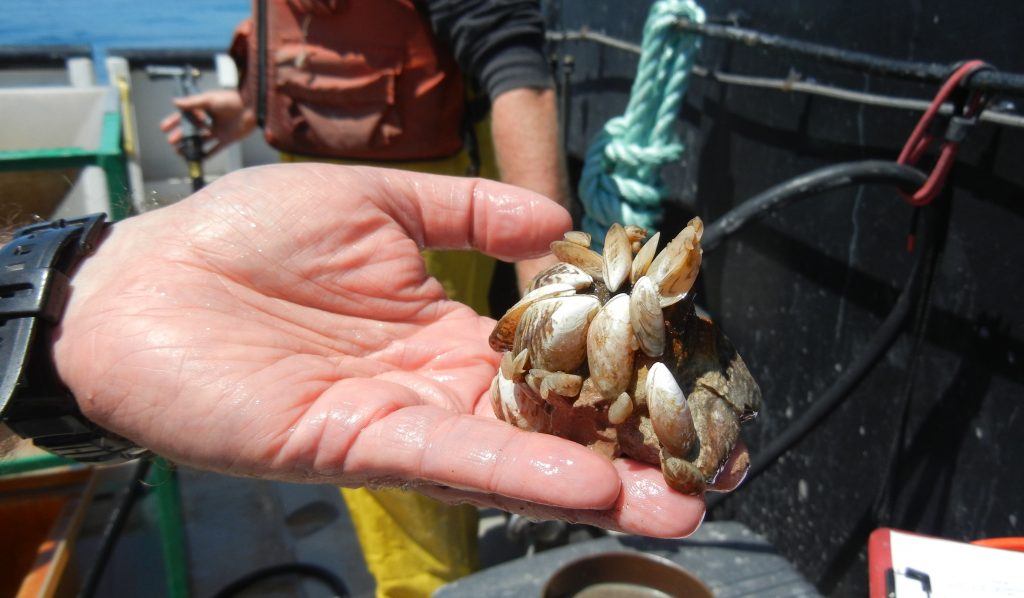
Rock covered in quagga mussels, collected in a Ponar grab in Lake Michigan during the 2015 CSMI benthic survey. (NOAA Great Lakes Environmental Research Laboratory)
NOAA-GLERL scientists also continue to explore the biology of invasive quagga mussels. Quagga mussels, which have largely replaced zebra mussels across the Great Lakes, have completely reengineered Lake Michigan by altering phytoplankton dynamics, providing new sources of food for other Lake Michigan organisms, and altering habitat characteristics along the lake bottom.
In 2021, a NOAA-GLERL-led team is focused specifically on assessing quagga mussel length-weight relationships and reproductive status. They are also examining veligers, which are very small, young mussels that are almost microscopic. The veliger stage is the only time that quagga mussels move freely with currents, and small fish and zooplankton likely take advantage of veligers as a food source.
Scientists from Wayne State University worked with NOAA-GLERL researchers to see if laboratory-reared larval yellow perch that were fed veligers performed less well than those fed other zooplankton. Preliminary results suggest that feeding on veligers can negatively affect larval yellow perch growth, making it important to gain a greater understanding of when and where veligers are available for organisms to eat so that scientists can understand the growth of all Lake Michigan fishes.
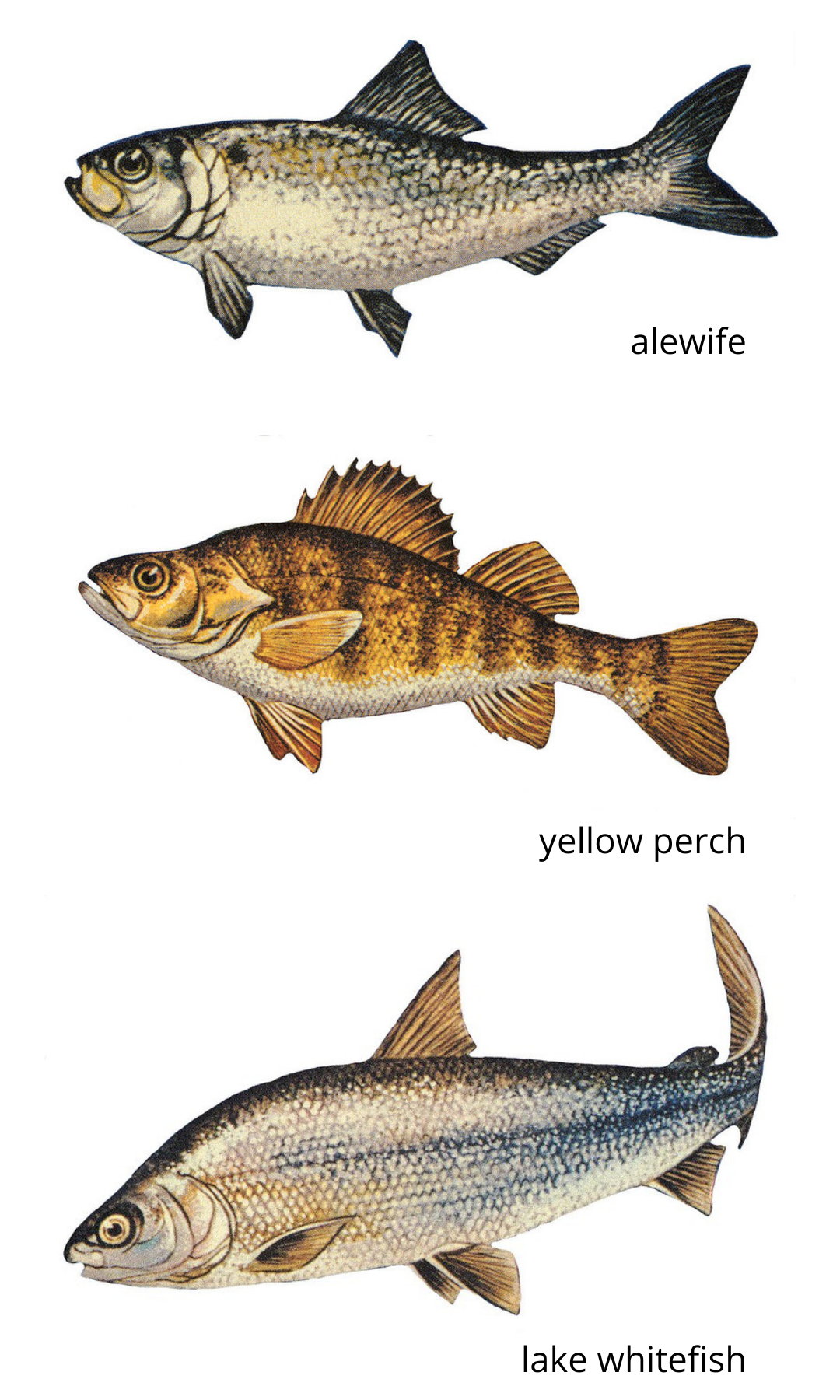
(NOOA Great Lakes Environmental Research Laboratory)
One of the most exciting efforts of the 2021 Lake Michigan CSMI sampling year is a major push to understand distributions and growth of young fish, including alewives, yellow perch and lake whitefish. Sampling conducted during the 2015 CSMI effort found that larval alewife growth in Lake Michigan had slowed about 40% since the early 2000s. Alewife are ecologically critical prey for larger fishes in Lake Michigan, and it is unclear if slower growth rates are related to food availability, food quality or other factors.
A team led by NOAA-GLERL did an intensive study along the Muskegon, Michigan transect to assess dynamics of all available larval and juvenile fish, including assessing the importance of night and day, depth, distance from shore and a large number of physical and abiotic variables, such as temperature and dissolved oxygen, on fish diets and growth. The team plans to combine their findings with efforts by the USGS Great Lakes Science Center and the EPA Great Lakes Toxicology and Ecology Division Laboratory, who in July sampled 15 transects across all of Lake Michigan for plankton and larval fish.
At each transect, the EPA team also measured the depth that UV radiation now penetrates. Water clarity in Lake Michigan has increased over the past 15 years, in part because quagga mussels have expanded to deeper portions of the lake, and it is possible that UV rays harm larval fish. This is likely the largest spatial coverage for larval fish sampling that has ever been undertaken in Lake Michigan, and nicely showcases what can happen when sampling among organizations is coordinated.
In early 2021, the USGS Great Lakes Science Center conducted weekly sampling of larval lake whitefish and available zooplankton prey along the beaches of St. Joseph and South Haven, Michigan; the southernmost locations in Lake Michigan to be sampled for lake whitefish larvae. By combining the results from these efforts with long-term lake whitefish beach sampling studies conducted by NOAA-GLERL and the Little Traverse Bay Bands of Odawa Indians (LTBB), scientists will better understand whether lake whitefish recruitment could be limited by zooplankton prey in their first weeks of life.
Purdue University scientists were also able to examine diets of larval whitefish collected from 2015 through 2019 by the LTBB, after samples were graciously provided, and plan to assess diet and growth patterns of larval alewife collected in southeastern Lake Michigan in 2021. All teams are eager to learn more about the larval fish community in the coming months as they shift from intensive field sampling to laboratory processing: measuring larval fishes, counting what is in their diets, and assessing growth.
The studies summarized here are far from the only efforts by scientists to understand Lake Michigan in 2021. Physical scientists at NOAA-GLERL deployed buoys and autonomous underwater vehicles to collect physical, chemical and biological observations in Lake Michigan, and NOAA-GLERL modelers created biophysical models to help visualize the movement of water and predict the locations of larval fish. USGS-GLSC scientists leveraged the existing Great Lakes Acoustic Observation System (GLATOS) network to better understand how lake whitefish and cisco select their habitats, and biologists were out as late as November 2021, tagging fish that will be tracked through 2022.
Scientists from several different partner organizations will use indicators like stable isotope ratios in organisms to determine food web structure, and further understand how energy is passed among Lake Michigan organisms. Illinois-Indiana Sea Grant looks forward to working with CSMI scientists to share the results of their work through online materials, presentations at conferences and written reports. To learn more about the 2015 CSMI Lake Michigan Field Year results, explore the story map Lake Michigan Health: A Deeper Dive.
Illinois-Indiana Sea Grant is a part of University of Illinois Extension and Purdue Extension.
Writer: Carolyn Foley
Contact: Paris Collingsworth
December 16th, 2021 by Hope Charters
Illinois-Indiana Sea Grant (IISG) is searching for someone to take over primary responsibility for development, delivery and evaluation of educational programs related to the Illinois Nutrient Loss Reduction Strategy and stormwater/green infrastructure programs supporting the mission of the University of Illinois Extension in conjunction with Illinois-Indiana Sea Grant. This position will work closely with the IISG’s water quality specialist to ensure nutrient loss reduction strategy and stormwater/green infrastructure standards are met. Bachelor’s degree related to subject matter emphasis and experience with agricultural conservation programs are required. To view the complete job description and apply, visit the listing on the Illinois Extension website. Closing date is January 7, 2022.
INCLUSION AND EQUAL OPPORTUNITY
University of Illinois is an equal access/equal opportunity university. We strongly encourage women, minorities, and people from traditionally underrepresented groups to apply. For more on Illinois-Indiana Sea Grant’s commitment to inclusion, please see our values statement.
Job Duties
Program Planning, Delivery and Evaluation
- Facilitate communication, meeting, and outreach strategies under the guidance of Illinois NLRS partners.
- Work with Illinois NLRS partners to acquire data, program information, and photos that advance NLRS reporting.
- Monitor the overall project timeline and track project successes through evaluation
- Evaluate and conduct data analysis and prepare data summaries and visualizations to show impacts.
- Develop and deliver presentations on nutrient loss and the statewide strategy to partners and stakeholders, including agricultural, commodity, municipal, and NGOs groups.
- Manage the professional, educational social media for projects.
- Using evaluation and analysis, document and compose a progress report every two years.
Scholarship
- Establish professional relationships and participate in campus-based partnerships that tie academic programs and research to complement Extension programming by partnering with Extension Specialists and/or faculty members on research projects as appropriate within the initiatives.
- Be an active member within a professional society(s) to keep abreast of changes within your discipline. Continually seek professional development opportunities to enhance competency in subject matter areas.
- Use research and evaluation findings to create innovative programs and make changes to existing programs in order to improve quality.
- Share principles of evidence-based best practice with peers.
- Identify funding opportunities for the Nutrient Loss Reduction Strategy, both public and private to meet project goals. Prepare and offer assistance preparing competitive grant proposals to fund the project.
Organizational Requirements
- Perform other duties that contribute to the mission of University of Illinois Extension programming, as assigned.
- Comply with all University of Illinois Extension Affirmative Action/Equal Opportunity policies and guidelines in all aspects of Extension work; assist unit staff with data collection for Affirmative Action, Gender, and Targeted reports as needed.
- Local, regional, statewide, and (limited) interstate travel required.
APPLICATION
To apply, go to https://go.illinois.edu/157121. Log in to your account and upload a cover letter and resume as well as the names and contact information of three professional references. Resume dates must be in month/year format and employment history, at a minimum, should include all work dating back to the completion of your undergraduate degree. Positions that were less than full-time/100% must be noted as being part-time. Transcripts may be requested at a later date. To receive full consideration, all requested application materials must be submitted via the online system by the close date of January 7, 2022.
Illinois-Indiana Sea Grant is a part of University of Illinois Extension and Purdue Extension.
December 6th, 2021 by Hope Charters
In this abbreviated interview, Colette Copic and Rachel Egly of the Keller Lab at Loyola University Chicago tell Illinois-Indiana Sea Grant Communications Associate Sarah Gediman about their research to contain invasive aquatic invertebrates. The team tested barriers on bloody red shrimp (Hemimysis anomala), zebra and quagga mussels (Dreissena spp.), rusty crayfish (Faxonius rusticus), red swamp crayfish (Procambarus clarkii), marbled crayfish (Procambarus virginalis), bladder snail (Physella acuta), Chinese Mystery Snail (Bellamya chinensis), Daphnia magna, and Hyalella azteca. While some of these species are not invasive, they served as substitutes for similar species that could become invasive.

Colette Copic (left) and Rachel Egly (right). (Keller Lab)
How did you become interested in studying aquatic barriers?
Egly: We have worked with several aquatic invasive species, but we were inspired by the current electric barrier in the Chicago Sanitary and Ship Canal. So far, this barrier has succeeded in blocking Asian carp, which can disrupt entire ecosystems and economies, from entering Lake Michigan. While this has worked well for Asian carp, we aren’t sure how electric barriers affect other types of organisms.

The first of three electric barriers in the Chicago Sanitary and Ship Canal was installed in 2002. (Sarah Gross / U.S. Army Corps of Engineers Chicago District)
Our lab was funded by Illinois-Indiana Sea Grant to look at how aquatic invasive invertebrates might respond to electric barriers and other methods of abating invasive species. I have been testing barriers using various strengths of electrical current, and Colette has been testing barriers made from carbon dioxide (CO2). We chose aquatic invasive species that have the potential to drastically change ecosystems should they become established populations.
Copic: Part of our motivation behind this project is that the scope is immense— canals are everywhere, and they aren’t going away anytime soon. We need them for trade, flooding management, and to be resilient to climate change, but every canal brings a free-flowing path for invasive species. If we can create canal management systems that allow ecosystem integrity, then this project has global implications. The question we want to answer is how we can have non-physical barriers in these canals so ships can pass through, but invasive species cannot.
We know electric barriers work, but what made you decide to test CO2 as a barrier?
Copic: The whole reason we’re thinking about this at all is that we know Asian carp avoid water with high CO2 concentrations in both the lab and the field. As I learned that, I thought, could this be a catch-all for other invasive species? Relative to other pesticides and biocides that we can use in water, CO2 is non-toxic and dissipates naturally. It won’t kill everything like a lot of other methods of keeping invasive species out, but it can immobilize and kill certain organisms, some of which are invasive.
How did you measure the efficacy of electric barrier and CO2 barrier techniques on your subject organisms?
Copic: I did two types of experiments. The first was in simple tanks to look at what behavioral effects carbon dioxide has on these creatures when they can’t escape. I tested their behavior on a range of carbon dioxide concentrations by observing the animals minute-by-minute in tanks with differing amounts of CO2. After recording the organisms, I got an idea of each species’ tolerance to CO2. Some become immobilized (wholly or partially), some are unaffected, and some die.
I also tested species that are mobile and can move across water to see if, given the choice, they would avoid high concentrations of carbon dioxide. I recorded where they were in the tank and saw that as levels of CO2 rise in one chamber, the animals will move to the chamber with lower levels of CO2.
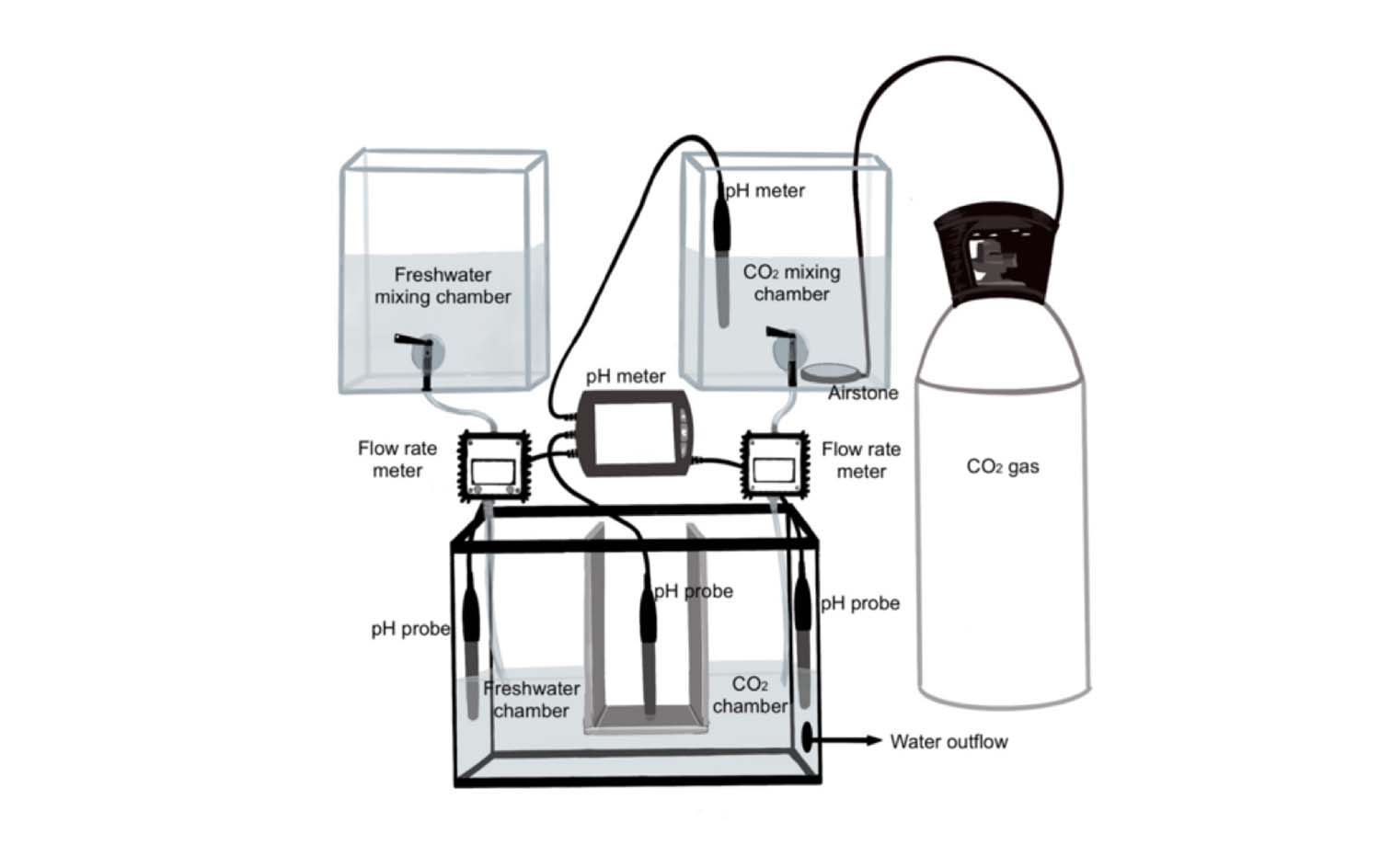
Diagram of tank arena to test carbon dioxide concentrations on mobile animals. (Keller Lab)
Egly: Like Colette, I measured by behavioral analysis, with similar results. Here is a diagram of the lab-scale electric fields used to mimic the one in the Chicago Sanitary and Ship Canal. We put wires on either side of a large fish tank and ran electricity between one steel plate electrode and the other, which created an electric field.
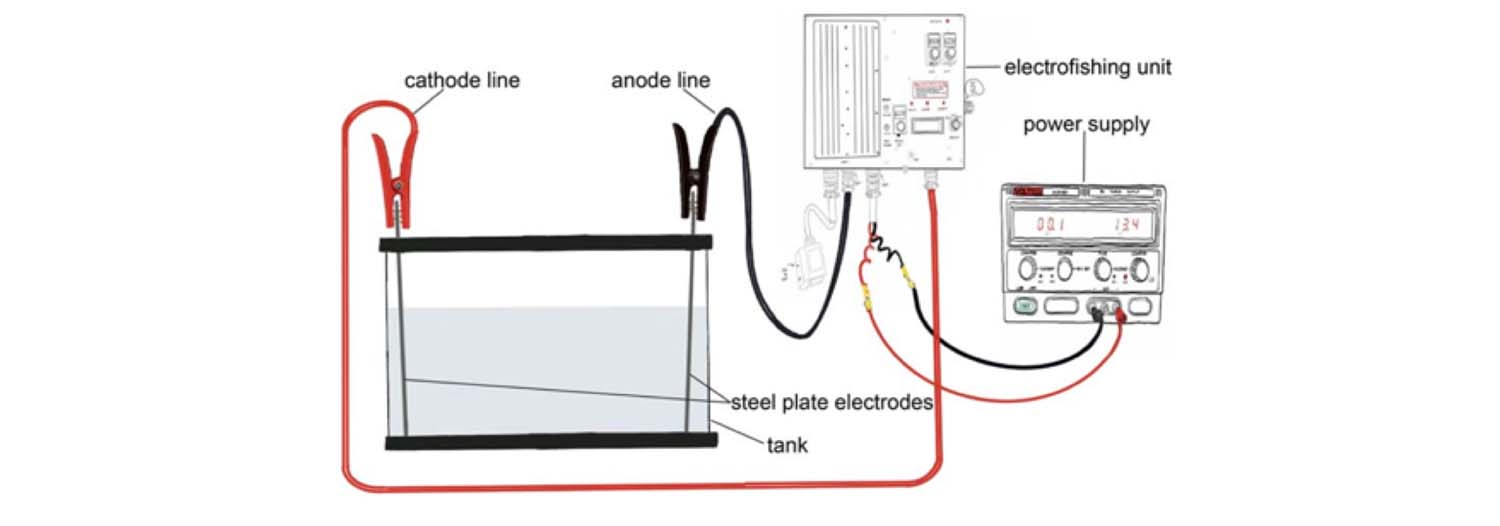
Diagram of experimental electric barrier setup, including power supply, electrofishing unit, tank, steel plate electrodes, and cathode and anode lines. (Keller Lab)

Diagram of electric barrier structure installed in the Chicago Sanitary and Ship Canal. (U.S. Army Corps of Engineers Chicago District)
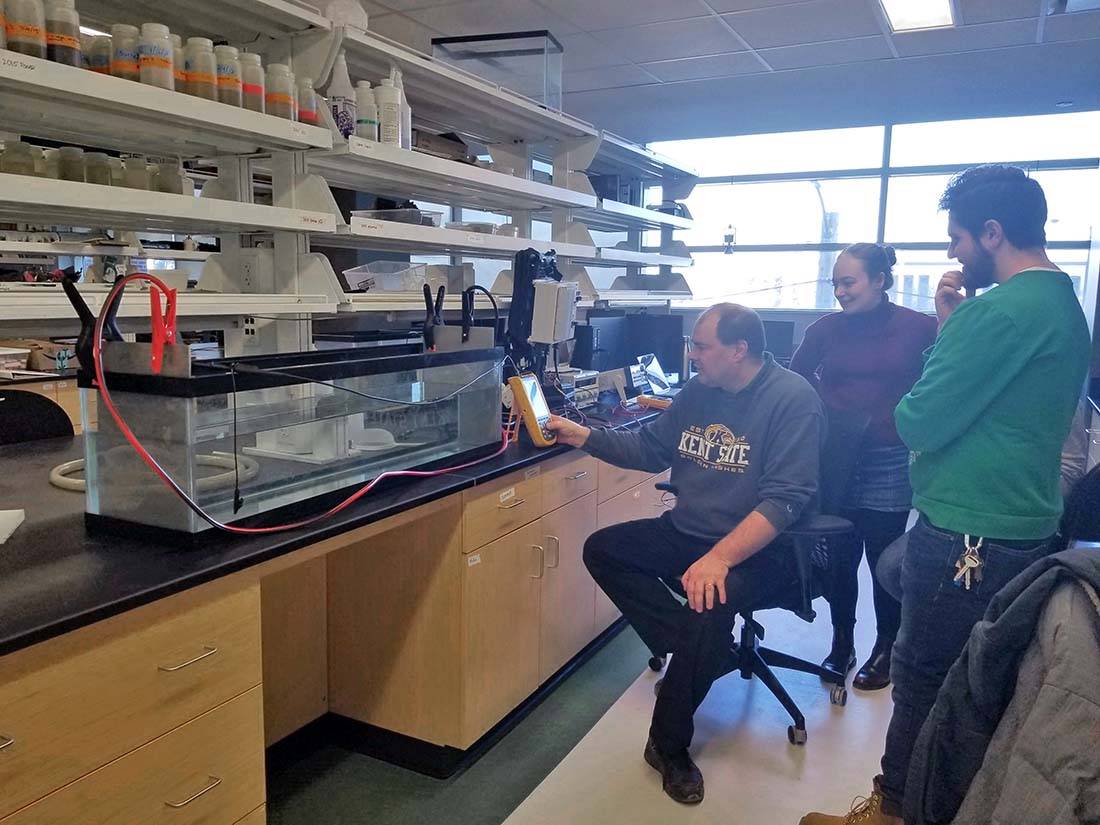
Researchers test the electric barrier setup at Loyola University. (Keller Lab)
What happens, ideally, when an organism comes into contact with CO2 or electrical currents?
Copic: I called the effect I saw narcotization because the CO2 was almost like a sedative. The crayfish would lose all muscle abilities and locomotive skills at higher CO2 concentrations. You could see they were experiencing stress as they got stiff, and some became completely frozen. I’d even poke them every five minutes and there would be no response. But then after just 10 minutes in fresh water without heightened CO2 concentrations, they were moving normally and it’s like it never happened.
Egly: I also found that even if the animals don’t exhibit a behavioral response such as lack of consciousness or motion, they still tend to orient themselves perpendicular to the electric barrier. So, we know that they’re feeling something, and they reduce their chance of being electrocuted by avoiding the barrier. We found that different species have different resistance to the electric barrier, so there is no single “ideal” strength of the electric field. The same is true for CO2 — different species react differently. Our results show that there is great promise for each of these types of barriers if the strength of each can be optimized.
What would these barrier systems look like in a real canal?
Egly: New electric barriers would look a lot like the current one in the Chicago Sanitary and Ship Canal, but with various amounts of electricity. In the existing structure, there are steel cables laid underneath the canal through which electricity is run to create a permeable division in the form of an electric field. This can be recreated in canals in many parts of the world.
Copic: Carbon dioxide really hasn’t been used much, so it’s tough to say. I’ve heard ideas about bubbling CO2 gas directly into strategic, small areas of the canal almost like a curtain. I’ve also heard the idea of having tanks on the side of canals, pumping CO2 and water inside, and releasing the mixture into canals when there is a high risk of species transmission. For example, when the shipping locks are open, or when electric barriers fail because they’re susceptible to power outages and might need maintenance.
You can learn more about the exciting research that Colette and Rachel are conducting in the Keller Lab at Loyola University Chicago by following @Craychel_Egly and @ColetteCopic on Twitter.
Illinois-Indiana Sea Grant is a part of University of Illinois Extension and Purdue Extension.
November 8th, 2021 by Hope Charters
In the face of climate change, scientific literacy among people in all professions is critical to a resilient community. To help make information accessible, Illinois-Indiana Sea Grant (IISG) specialists Kara Salazar and Leslie Doworth have teamed up with Melissa Widhalm—formerly of Purdue Climate Change Research Center, currently with the Midwestern Regional Climate Center—to author a series of publications about climate change in Indiana. The team drew on their backgrounds in community planning, water quality and climate change, respectively, to consolidate important information about the local effects of climate change and how to address them.
They chose four areas of focus based on feedback from various stakeholders associated with the Purdue Land Use Team and community planning program efforts through IISG and Purdue Extension. Throughout these four publications, the most recent climate science data are presented in topics such as precipitation and temperature extremes. There are also introductions to community planning frameworks, such as the One Water approach, and resources to support communicating about climate to diverse audiences.
“The problem of climate change is far reaching, but there are many strategies communities can implement to manage impacts,” said Kara Salazar, IISG’s assistant program leader and extension specialist for sustainable communities. “The more that decision makers, and the public as a whole, understand how global climate change will impact our communities, the better we can adjust local natural resources management and planning efforts.”
The climate publications are an updated version of documents originally published by the (now retired) Purdue Planning with POWER (protecting our water and environmental resources) Program over ten years ago. Since then, researchers’ understanding of how climate change will manifest locally has deepened dramatically. The new resources include recent research and expectations about local change that are tailored for Indiana communities.
The authors hope that these publications will be a valuable educational resource for local government officials, plan commission members and anyone with an interest in the climate and environment. Salazar said, “They can be a way for anyone to have an introduction to the topic.” For those who are interested in community planning in the face of climate change in or around Indiana, this is the place to start.
Illinois-Indiana Sea Grant is a part of University of Illinois Extension and Purdue Extension.
Writer: Sarah Gediman
Contacts: Kara Salazar, Leslie Dorworth




















